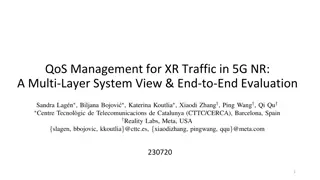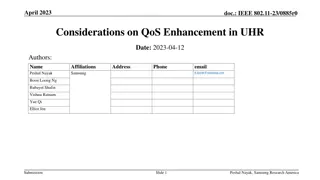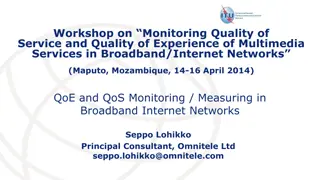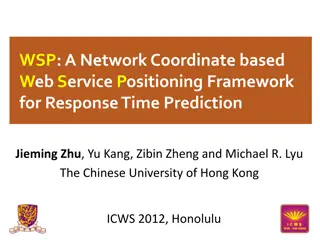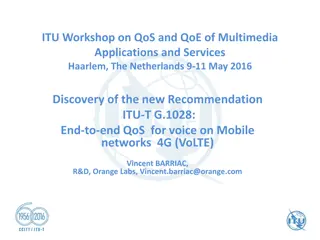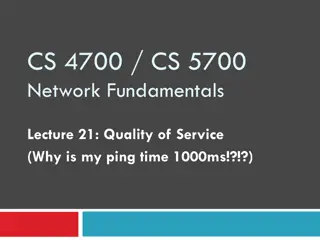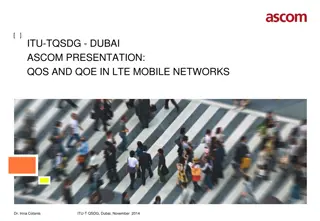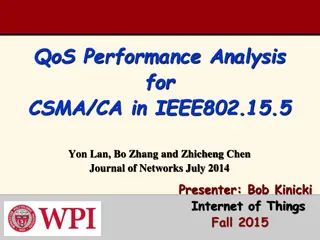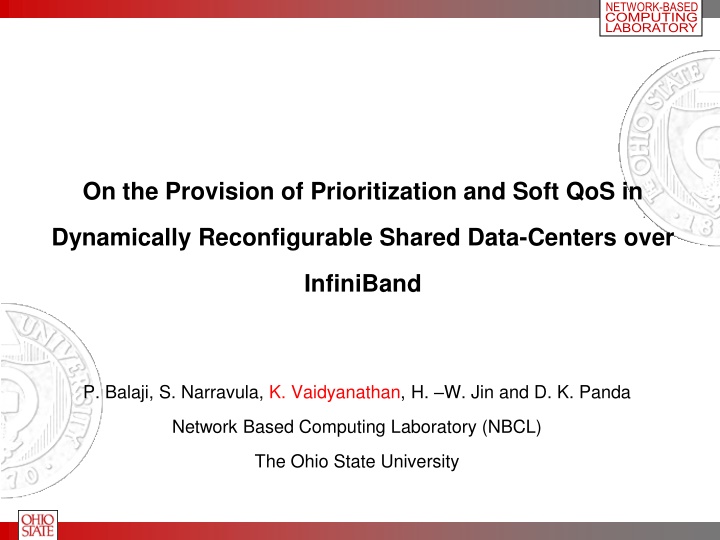
Soft QoS Provision in Dynamic Data Centers Over InfiniBand
Explore prioritization & Soft QoS in shared data centers using InfiniBand technology. Learn about dynamic reconfigurability, COTS clusters, & cluster-based data centers for efficient network computing.
Download Presentation

Please find below an Image/Link to download the presentation.
The content on the website is provided AS IS for your information and personal use only. It may not be sold, licensed, or shared on other websites without obtaining consent from the author. If you encounter any issues during the download, it is possible that the publisher has removed the file from their server.
You are allowed to download the files provided on this website for personal or commercial use, subject to the condition that they are used lawfully. All files are the property of their respective owners.
The content on the website is provided AS IS for your information and personal use only. It may not be sold, licensed, or shared on other websites without obtaining consent from the author.
E N D
Presentation Transcript
NETWORK BASED COMPUTING LABORATORY On the Provision of Prioritization and Soft QoS in Dynamically Reconfigurable Shared Data-Centers over InfiniBand P. Balaji, S. Narravula, K. Vaidyanathan, H. W. Jin and D. K. Panda Network Based Computing Laboratory (NBCL) The Ohio State University
NETWORK BASED COMPUTING LABORATORY Presentation Outline Introduction and Motivation Overview of Dynamic Reconfigurability over InfiniBand Issues with Basic Dynamic Reconfigurability Dynamic Reconfigurability with Prioritization and Soft QoS Experimental Results Conclusions and Future Work
NETWORK BASED COMPUTING LABORATORY COTS Clusters Commodity-Off-the-Shelf (COTS) Clusters High Performance-to-Cost Ratio Enabled through High Performance Networks Advent of High Performance Networks Ex: InfiniBand, Myrinet, Quadrics, 10-Gigabit Ethernet High Performance Protocols: VAPI / IBAL, GM, EMP Provide applications direct and protected access to the network InfiniBand: An Industry Standard High Performance Network Architecture Low latency (< 4us) and high throughput (near wire speed = 10Gbps) Offloaded Protocol Stack, Zero-copy data transfer, One-sided communication (RDMA read/write, atomics, etc) InfiniBand-based COTS Clusters are becoming extremely popular !
NETWORK BASED COMPUTING LABORATORY Cluster-based Data-Centers Increasing adoption of Internet Primary means of electronic interaction Highly Scalable and Available Web-Servers: Critical ! Utilizing Clusters for Data-Center environments? Studied and Proposed by the Industry and Research communities Mid tier Applications Front tier Applications Back end Applications Nodes are logically partitioned Edge Services Interact depending on the query Provide services requested Internet Load increases in the inner Enterprise Network tiers (Courtesy CSP Architecture Design)
NETWORK BASED COMPUTING LABORATORY Shared Multi-Tier Data-Centers Load Balancing Cluster (Site A) Website A Clients Servers Load Balancing Cluster (Site B) Website B WAN Servers Clients Load Balancing Cluster (Site C) Website C Servers Fragmentation of resources Service differentiation QoS guarantees
NETWORK BASED COMPUTING LABORATORY Objective Fragmentation of resources needs to be curbed [balaji04_reconf] Dynamically configuring nodes allotted to each service Service differentiation for different websites hosted Intelligent dynamic reconfiguration based on pre-defined prioritization rules QoS guarantees for low-priority requests Ensure that low priority websites are given certain minimal resources at all times Can the advanced features provided by InfiniBand help in providing dynamic reconfigurability with QoS and prioritization for different websites? balaji04_reconf: Exploiting Remote Memory Operations to Design Efficient Reconfiguration for Shared Data- Centers over InfiniBand . P. Balaji, K. Vaidyanathan, S. Narravula, S. Krishnamoorthy, H. W. Jin and D. K. Panda. In the RAIT workshop, held in conjunction with Cluster 2004.
NETWORK BASED COMPUTING LABORATORY Presentation Outline Introduction and Motivation Overview of Dynamic Reconfigurability over InfiniBand Issues with Basic Dynamic Reconfigurability Dynamic Reconfigurability with Prioritization and Soft QoS Experimental Results Conclusions and Future Work
NETWORK BASED COMPUTING LABORATORY Basic Dynamic Reconfigurability (Reconf) Website A Load Balancing Cluster (Site A) Clients Servers Load Balancing Cluster (Site B) Website B WAN Servers Clients Load Balancing Cluster (Site C) Website C Servers Nodes reconfigure themselves to highly loaded websites at run-time
NETWORK BASED COMPUTING LABORATORY Reconf Design Support for Existing Applications Utilizing External Helper Modules (external programs running on each node) to take care of load monitoring, reconfiguration, etc. Load-Balancer based vs. Server based Reconfiguration Remote Memory Operations based Design Locking and Data Sharing are based on InfiniBand one-sided operations and atomics Load-balancers remotely monitor and reconfigure the system
NETWORK BASED COMPUTING LABORATORY Utilizing InfiniBand Features Two-level hierarchical locking mechanism Both locks performed remotely using InfiniBand Atomic Operations Completely load resilient design Server Website A Load Server Website B Balancer B Loaded Not Loaded Load Query Load Query Lock Data Sharing Reconfigure Node (Atomic) Unlock Load Shared Load Shared
NETWORK BASED COMPUTING LABORATORY Presentation Outline Introduction and Motivation Overview of Dynamic Reconfigurability over InfiniBand Issues with Basic Dynamic Reconfigurability Dynamic Reconfigurability for Prioritization and Soft QoS Experimental Results Conclusions and Future Work
NETWORK BASED COMPUTING LABORATORY Issues with Reconf on High Priority Requests Load Balancing Cluster (Site A) Website A (low priority) Servers Clients Load Balancing Cluster (Site B) Website B (medium priority) Servers WAN Clients Load Balancing Cluster (Site C) Website C (high priority) Servers SCARCITY High Priority website may get lesser number of servers compared to medium/low priority websites since Reconf does not have any idea about Prioritization between websites
NETWORK BASED COMPUTING LABORATORY Presentation Outline Introduction and Motivation Overview of Dynamic Reconfigurability over InfiniBand Issues with Basic Dynamic Reconfigurability Dynamic Reconfigurability for Prioritization and Soft QoS Experimental Results Conclusions and Future Work
NETWORK BASED COMPUTING LABORATORY Dynamic Reconfigurability with Prioritization (Reconf-P) Prioritization support for Reconf Reconf requires additional logic to be priority aware Pre-defined rules for prioritization amongst various websites Reconfiguration is website priority aware A node is said to be a free node if one of the following is true: It is lightly loaded It is serving a website with a lower priority than the requesting website
NETWORK BASED COMPUTING LABORATORY Reconf with Prioritization Load Balancing Cluster (Site A) Website A (low priority) Servers Clients Load Balancing Cluster (Site B) Website B (medium priority) Servers WAN SCARCITY Clients Load Balancing Cluster (Site C) Website C (high priority) Servers Low Priority websites may never get guaranteed number of servers since Reconf-P does not have any idea about QoS guarantees for websites
NETWORK BASED COMPUTING LABORATORY Dynamic Reconfigurability with Prioritization and Soft QoS Guarantees (Reconf-PQ) Prioritization based Dynamic Reconfigurability Allows high paying websites to achieve a better performance Can result in scarcity of resources for low priority websites QoS guarantees required to ensure scarcity-free reconfiguration Static allocation always provides QoS guarantees Low priority requests are given resources statically and never taken away QoS provided based on the resources available Reconf-PQ based design We want to ensure that low priority requests have some guaranteed resources (Hard QoS) We also want to achieve greater revenue by over-selling our resources Soft QoS Guarantees: Maximum resources we can allot based on other requests ! Soft QoS ensures that a websites allocation does not deny other websites of their Hard QoS
NETWORK BASED COMPUTING LABORATORY Reconf with Prioritization and QoS Load Balancing Cluster (Site A) Website A (low priority) Servers Clients Load Balancing Cluster (Site B) Website B (medium priority) Servers WAN Hard QoS Maintained Clients Load Balancing Cluster (Site C) Website C (high priority) Servers Reconf-PQ reconfigures nodes for different websites but also guarantees fixed number of nodes to low priority requests
NETWORK BASED COMPUTING LABORATORY Presentation Outline Introduction and Motivation Overview of Dynamic Reconfigurability over InfiniBand Issues with Basic Dynamic Reconfigurability Dynamic Reconfigurability for Prioritization and Soft QoS Experimental Results Conclusions and Future Work
NETWORK BASED COMPUTING LABORATORY Experimental Test-bed Cluster 1 with: 8 SuperMicro SUPER X5DL8-GG nodes; Dual Intel Xeon 3.0 GHz processors 512 KB L2 cache, 2 GB memory; PCI-X 64-bit 133 MHz Cluster 2 with: 8 SuperMicro SUPER P4DL6 nodes; Dual Intel Xeon 2.4 GHz processors 512 KB L2 cache, 512 MB memory; PCI-X 64-bit 133 MHz InfiniBand Interconnect with: Mellanox MT23108 Dual Port 4x HCAs; MT43132 24-port switch Apache 2.0.50 Web and PHP 4.3.7 servers; MySQL 4.0.12 Database server
NETWORK BASED COMPUTING LABORATORY Experimental Outline Load resilience capabilities of InfiniBand in the data- center environment Performance of Reconf comparing with static allocation schemes Performance of Reconf, Reconf-P, Reconf-PQ QoS meeting capabilities for Reconf, Reconf-P, Reconf-PQ
NETWORK BASED COMPUTING LABORATORY Load resilience capabilities of InfiniBand Impact on Bandwidth Impact on Latency 1400 900 800 1200 700 1000 Bandwidth (MBps) 600 Latency (us) 800 500 400 600 300 400 200 200 100 0 0 1 2 4 8 16 32 64 1 2 4 8 16 32 64 Number of Background Threads Number of Background Threads 64B RDMA Read 64B IPoIB 32k RDMA Read 32k IPoIB Remote memory operations are not affected AT ALL with remote server load
NETWORK BASED COMPUTING LABORATORY Basic Reconfigurability Performance 7 Transactions per Second 50000 6 Number of busy nodes 40000 5 30000 4 20000 3 10000 2 1 0 0 1K 2K 4K 8K 16K Burst Length (requests) 0 9421 18520 Iterations 23570 28570 Rigid (Small) Reconf Rigid (Large) Reconf Rigid-Small Rigid-Large Large Burst Length allows reconfiguration of the system closer to the best case; reconfiguration time is negligible; Performs comparably with the static scheme for small burst sizes
NETWORK BASED COMPUTING LABORATORY Reconfigurability Performance with QoS and Prioritization Low Priority Requests Performance High Priority Requests Performance 25000 25000 Transactions per Second Transactions per Second 20000 20000 15000 15000 10000 10000 5000 5000 0 0 Case 1 Case 2 Case 3 Case 1 Case 2 Case 3 Reconf Reconf-P Reconf-PQ Reconf Reconf-P Reconf-PQ Case 1: A load of high priority requests arrives when a load of low priority requests already exists Case 2: A load of low priority requests arrives when a load of high priority requests already exists Case 3: Both high and low priority requests arrive simultaneously Reconf does not perform any additional reconfiguration Reconf and Reconf-P allocate maximum number of nodes to the low-priority website whereas Reconf-PQ allocates nodes to the QoS guaranteed to that website.
NETWORK BASED COMPUTING LABORATORY QoS Meeting Capability Hard QoS Meeting Capability (High Priority Requests) 100% Hard QoS Meeting Capability (Low Priority Requests) 100% % of times QoS met % of times QoS met 80% 80% 60% 60% 40% 40% 20% 20% 0% 0% Case 1 Reconf Case 2 Reconf-P Case 3 Case 1 Reconf Case 2 Reconf-P Case 3 Reconf-PQ Reconf-PQ Reconf and Reconf-P perform well only in some cases and lack consistency in providing the guaranteed QoS requirements to both websites Reconf-PQ meets the guaranteed QoS requirements in all cases
NETWORK BASED COMPUTING LABORATORY QoS Meeting Capability Zipf and Worldcup Traces Hard QoS Meeting Capability (Low Priority Requests) 100% Hard QoS Meeting Capability (Low Priority Requests) 100% % of times QoS met % of times QoS met 80% 80% 60% 60% 40% 40% 20% 20% 0% 0% Case 1 Case 2 Case 3 Case 1 Reconf Case 2 Case 3 Reconf-P Reconf-PQ Reconf Reconf-P Reconf-PQ Similar trends are seen for Zipf and Worldcup traces with QoS meeting capability of nearly 100% for Reconf-PQ
NETWORK BASED COMPUTING LABORATORY Presentation Outline Introduction and Motivation Overview of Dynamic Reconfigurability over InfiniBand Issues with Basic Dynamic Reconfigurability Dynamic Reconfigurability for Prioritization and Soft QoS Experimental Results Conclusions and Future Work
NETWORK BASED COMPUTING LABORATORY Concluding Remarks & Future Work Shared Data-Centers are commonly used by several ISPs Resource Fragmentation Prioritization for high paying websites QoS guarantees for all websites Extended our previous Dynamic Reconfigurability scheme Prioritization improves the performance of high priority websites QoS guarantees protect the low priority websites from scarcity of resources Multi-Stage Reconfigurations Least loaded servers might not be the best server to reconfigure, Caching constraints, Hardware heterogeneity Fine Grained Resource Reconfigurations Have done some initial study on file system reconfigurations Memory reconfiguration: utilizing remote memory in clusters as secondary cache
NETWORK BASED COMPUTING LABORATORY Web Pointers Network Based Computing Laboratory NBC-LAB Group Homepage: http://nowlab.cis.ohio-state.edu Emails: {balaji, narravul, vaidyana, jinhy, panda}@cse.ohio-state.edu

